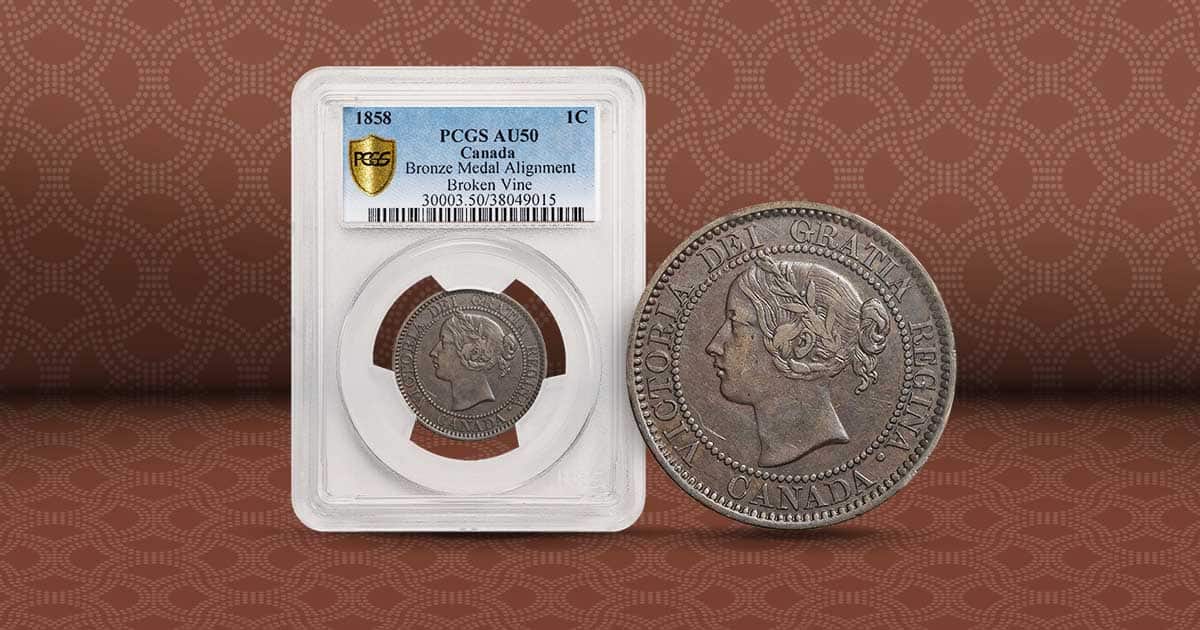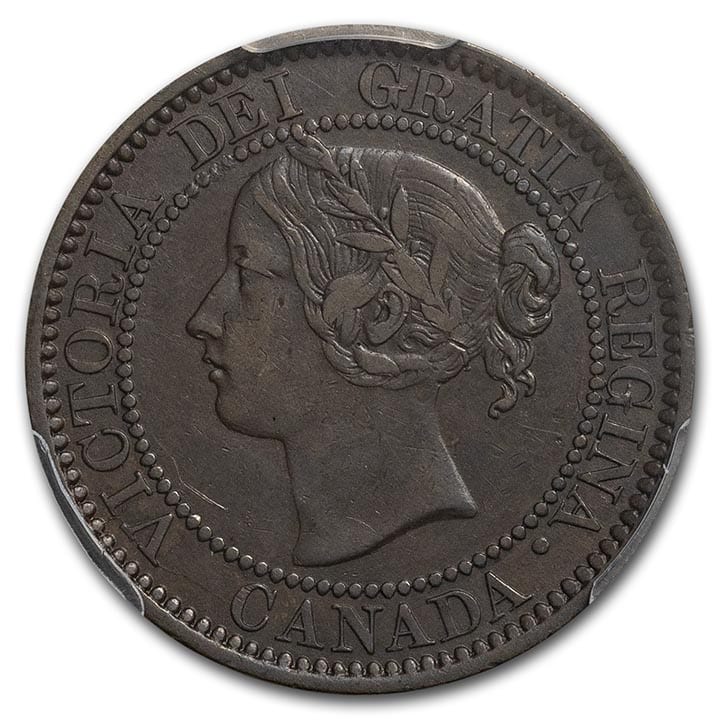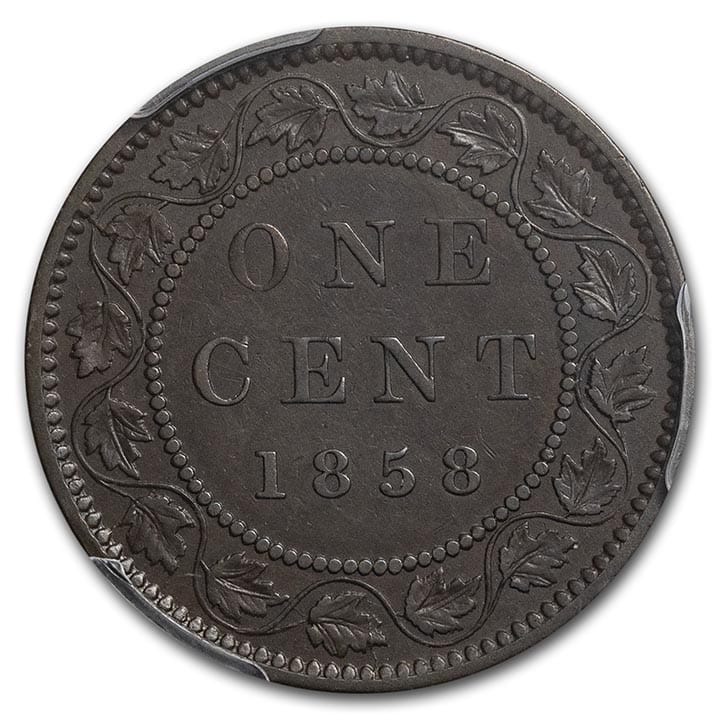
Canadian Cents were first struck in 1858 and discontinued in 2012, meaning Canada no longer produces a one cent coin for circulation. While they remain legal tender coinage, most products were rounded up in price to the nearest nickel.
Starting back in 1858, the Canadian government decided to strike their own coinage in order to end their reliance upon British currency, which freely circulated throughout the country. At the time, Canadian commerce also relied heavily on US coinage, privately issued tokens, and even Spanish Milled Dollars as currency. Shortly after, Canada began producing Five Cent, Ten Cent and Twenty Cent coins as well.
Province of Canada Large Cents
The Province of Canada struck Large Cent coins in both 1858 and 1859. As they were experimenting, they struck coins with both a medal alignment (same turn) as well as a coin alignment (flip over turn).
Queen Victoria (1858 to 1901)
1858 Large Cent – Medal Alignment
The government struck 421,000 of these 1858-dated coins, but they were not well-received across the country. This was because these coins were both large and heavy, and the year prior (1857) the United States Mint discontinued the American Large Cent due to unpopularity of the size and the rising price of copper.
Both the obverse and reverse were designed by Leonard Charles Wyon. The obverse depicts the head of a young Queen Victoria, facing left. She is wearing a laurel wreath in her hair and around the outer perimeter of the coin is the Latin inscription, “VICTORIA DEI GRATIA REGINA. CANADA.”
(Translated to “Victoria, Queen by the Grace of God.”)
The reverse of the coin has an inner circle with the denomination in two lines and the date underneath. The outer perimeter contains a vine adorned with 16 maple leaves.
The coins were struck at the Royal Mint, Tower Hill, in London, Great Britain.


1859 Canadian Large Cent
Due to the large number of coins struck, 9,579,000, there were as many as 16 different Canadian Penny varieties created in 1859. The Narrow 9 is the most common of the varieties, but others include the Narrow 9 over Inverted 9, Wide 9, and at least 5 different Double-Punched Narrow 9’s and a 9 Over 8.
A complete collection of all known 1859 Large Cent varieties would be quite challenging and would even include a rare brass struck variety.
There were no coins struck until 1876 in order to let the nearly 10 million 1859-dated coins circulate.
1891 Large Cent/Large Leaf & Large Date, Large Leaf & Small Date, Small Leaf & Small Date
The total mintage of 1891-dated coins was 1,452,500. The most common variety is the Large Leaf with a Large Date.
The scarcest coin is the Large Date with a Small Date. The less-scarce variety is the Small Leaf Coin with the Small Date. As it is easy to confuse the varieties and there is a significant value to each, NGC or PCGS certifications are highly recommended.
1894 Canadian Large Cent
The 1894 Large Cent saw 1,000,000 coins struck. This time, the ‘Large Cent’ was not only accepted for commerce, but truly needed. People no longer complained about the size and weight of the coins.
King Edward (1902 – 1910)
1907-H Large Cent
These coins were struck at the Birmingham Mint, with an ‘H’ mintmark. The total mintage struck here was only 800,000 coins. The ‘H’ mintmark is below the date on the reverse. This mintage was well-below the 2,400,000 coins struck at the Royal Mint.
King George V (1911 – 1920)
During the reign of King George V from 1911 to 1920, there were no scarce dates of varieties of Large Cents that were struck.
King George V (1920 – 1936)
Beginning in mid-1920, the Large Cent was discontinued, and a smaller one cent coin was struck. It was significantly smaller, very similar in size to the US one cent coin.
1922 Canadian Small Cent
The 1922 cent had only 1,243,635 coins struck. It is one of the first scarce dates of the small cent series.
1923 Canadian Small Cent
There was another scarce date during the following year. 1923 saw a scant mintage of only 1,019,002 coins struck, making this another early scarce date coin.
1925 Canadian Small Cent
The total mintage of the 1925 Small Cent was 1,000,622 coins struck. It is truly a scarce date.
1936 Canadian DOT Small Cent
King George V died in January of 1936, but coins had already been struck bearing his effigy. It was presumed that the next ruler would be King Edward VIII. As the Mint prepared new coinage, Edward had other plans. He abdicated his throne in December in order to marry Wallis Simpson, a divorced American woman. So instead, his brother would assume the throne as King George VI. Now, new 1936-dated coins bearing King George VI’s effigy were struck into 1937. In order to differentiate between those and other 1936-dated coins, the Royal Canadian Mint added a tiny, raised dot just below the date on the reverse.
But while the Mint struck 678,823 coins with the raised dot, they were found not to be needed at all and virtually all of them were later melted. Virtually. But a tiny handful of specimens (3 to 4 coins) did survive to this day.
King George VI (1937 – 1952)
With the abdication of King Edward VIII, in order to marry Wallis Simpson, the throne was assumed by Edward’s brother who became King George VI.
No scare dates or varieties were struck during this period.
Queen Elizabeth II (1953 – 2012)
England’s longest reigning monarch was Queen Elizabeth II, who was coronated in 1953 and served until her passing in 2022. Her effigy remained on Canadian cents until the denomination’s discontinuation in 2012.
1954 Cent – No Shoulder Fold:
On numerous coins dated between 1954 and 1955, the shoulder fold on the Queen’s dress had been polished away off of the dies, creating a ‘No Shoulder Fold’ varieties which are all collectible and scarce.
1955 Cent – No Shoulder Fold
The 1953 version of the ‘No Shoulder Fold’ is fairly common. The 1954 version is the scarcest while the 1955 version is scarce.
1965 Cent Var 4, Large Beads, Pointed 5
There are numerous varieties of the 1965 cents. This particular variety has a Pointed 5 upper serif and large beads around the denticles.
1985 Pointed 5
The 1985 Canadian Cent has a Blunt 5, which is the common variety. There is a scarce variety that has a Pointed 5 upper serif.
2006 Cent, Magnetic, No ‘P’, No Logo
The total mintage of this special issue is 222 coins. This cent is magnetic without the letter ‘P’ or the RCM logo.
Canadian Penny Values – Large Cents
| Date MM | Mintage | Very Fine | Abt Unc | Ch Unc |
| Large Cents | ||||
| 1858 | 421,000 | $130 | $300 | $650 |
| 1859 Nr 9 | 9,579,000 | $6 | $25 | $140 |
| 1859 Brass | Included | $20,000 | — | — |
| 1891 LL, LD | 1,452,500 | $9 | $60 | $240 |
| 1891 LL,SD | Included | $150 | $500 | $2,200 |
| 1891 SL,SD | Included | $100 | $225 | $600 |
| 1894 | 1,000,000 | $20 | $75 | $150 |
| 1907-H | 800,000 | $25 | $100 | $300 |
| Common | — |
Canadian Penny Values – Small Cents
| Date MM | Mintage | Very Fine | Abt Unc | Ch Unc |
| Small Cents | ||||
| 1922 | 1,243,635 | $25 | $125 | $475 |
| 1923 | 1,019,002 | $35 | $175 | $600 |
| 1925 | 1,000,622 | $30 | $125 | $400 |
| 1936 Dot | 3 to 4 | —- | $175,000 | $275,000 |
| 1954 N S F | Included | — | — | $1,800 |
| 1955 N S F | Included | $225 | $500 | $2,500 |
| 1965 #4, Lg Beads, Ptd 5 | Included | $20 | $30 | $100 |
| 1985 Ptd 5 | Included | $20 | $35 | $60 |
| 2006 Magnetic | 222 | $25 | $60 | $150 |





